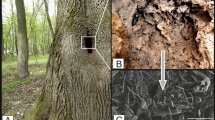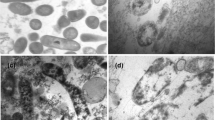Abstract
IN connexion with an attempt to isolate pheromone1 from the queens of the honey bee, Apis mellifica L., an examination was carried out on the neutal portion of the extract obtained by perfusion of the powdered whole-bodies of the queens with ethanol and tert-butanol. By chromatographing the neutral portion on alumina, or silica gel, a crystalline substance, m.p. 138–145° C. [α]D 25 = −31.6 ± 6° (c = 0.39 in chloroform), was obtained, which resembled cholesterol in behaviour and chemical properties. The Liebermann-Burchard reaction gave the same coloration as that obtained with cholesterol and the mixed melting point was the same. However, there were two bands (6.08µ and 11.33µ) in the infra-red spectrum of the substance which are not found in the spectrum of cholesterol and its derivatives. The same substance was isolated by similar means from worker bees. The constitution 1 for the sterol was elucidated from the following: An Oppenauer oxidation using cyclohexanone and aluminium isopropylate in toluene produced a conjugated unsaturated ketone; m.p. 77–84° C., λmax = 242 mµ, log ɛ = 4.0 calculated for C28H44O, 396.6. Besides, the double bond of the αβ-unsaturated ketone function, a second double bond was present as shown by titration with bromine3 (1.155 mgm. of substance used, in 4 hr. 0.934 mgm. bromine which corresponds to 2.01 moles C28H44O by calculation. From the absorption bands at 6.08µ and 11.33µ (pressed in potassium bromide) it was inferred that one of the double bonds was present4 as a methylene group (C = CH2). Similarly 26 per cent of the theoretical yield of formaldehyde was formed on reaction with 10 moles of ozone. Based on these properties we have compared the free sterol and the O-acetyl-compound with 24-methylene-cholesterol and its O-acetyl-derivative5 (Table 1).
Similar content being viewed by others
References
Karlson, P., and Lüscher, M., Naturwiss, 46, 63 (1959). Karlson, P., and Butenandt, A., “Ann. Review Entormol.”, 4, 39 (1959).
Meystre, Ch., Frey, H., Neher, R., Wettstein A., and Miescher, K., Helv. Chim. Acta, 29, 627 (1946).
Gorbach, G., Mikrochimic. Acta, 31, 320 (1944); glacial acetic acid was chosen in place of CCl4 as solvent for the bromination
Bellamy, L. J., “The Infra-red Spectra of Complex Molecules”, p. 44 (London, 1954); see also: Burford, R. R., Hewgil, F. R., and Jefferies, P. R., J. Chem. Soc., 2937 (1957). Sondheimer, F., and Mechoulam, R., J. Amer. Chem. Soc., 79, 5029 (1957). Willhelm, B., Steiner, U., and Schinz, H., Helv. Chim. Acta, 41, 1359 (1958).
Idler, D. R., and Fagerlund, U. H. M., J. Amer. Chem. Soc., 79, 1988 (1957). Bergmann, W., and Dusza, J. P., Liebigs Ann., 603, 36 (1957).
Idler, D. R., and Fagerlund, U. H. M., J. Amer. Chem. Soc., 77, 4142 (1955). Fagerlund, U. H. M., and Idler, D. R., J. Organic Chemistry, 21, 372 (1956).
Parson, J., Beher, W. T., and Baker, G. D., Henry Ford Med. Bull., 6, 365 (1958).
Author information
Authors and Affiliations
Rights and permissions
About this article
Cite this article
BARBIER, M., REICHSTEIN, T., SCHINDLER, O. et al. Isolation of 24-Methylene-cholesterol from Honey Bees (Apis mellifica L). Nature 184, 732–733 (1959). https://doi.org/10.1038/184732a0
Issue Date:
DOI: https://doi.org/10.1038/184732a0
- Springer Nature Limited
This article is cited by
-
Architecture of the native major royal jelly protein 1 oligomer
Nature Communications (2018)
-
�ber den Sterinbestand einiger Clitellatenarten und �ber die Sterinresorption bei Lumbricus terrestris L.
Zeitschrift f�r Vergleichende Physiologie (1964)
-
Identifizierung von β-Sitosterin als Hauptsterin des Kartoffelkäfers (Leptinotarsa decemlineata Say)
Experientia (1961)





